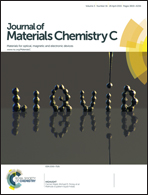M3+[amaranth red]3− (M = La, Gd): a novel sulfonate-based inorganic–organic hybrid nanomaterial for multimodal imaging
Abstract
Lanthanum and gadolinium amaranth-red hybrid nanoparticles consist of an inorganic cation M3+ (M = La, Gd) and the fluorescent organic dye anion [AMA]3− (AMA: amaranth red, C20H11N2O10S3) that is systematically named (4E)-3-oxo-4-[(4-sulfonatonaphth-1-yl)hydrazinyliden]naphthalin-2,7-disulfonate (as well named E123, C.I. 16185, Acid Red 27, C-Red 46, Echtrot D, or Food Red 9). M3+[AMA]3− (M = La, Gd) nanoparticles are prepared via aqueous synthesis as highly stable colloidal suspensions with a mean particle diameter of 47 nm. The chemical composition is validated by infrared spectroscopy (FT-IR), energy-dispersive X-ray analysis (EDX), thermogravimetry (TG) and elemental analysis (EA). M3+[AMA]3− (M = La, Gd) shows intense red emission (λmax = 700 nm) upon excitation at 400–650 nm. Even after 15 hours of UV irradiation (310 nm), the nanoparticles do not show any significant photobleaching. Based on its red fluorescence and its Gd3+-based magnetism, especially, Gd3+[AMA]3− nanoparticles can be interesting as a multimodal contrast agent for biomedical applications or as a magneto-optical marker in polymers. This holds even more in view of biocompatibility, high dye load (79 wt%), excellent photostability, and water-based synthesis of the M3+[AMA]3− (M = La, Gd) inorganic–organic hybrid nanoparticles.
![Graphical abstract: M3+[amaranth red]3− (M = La, Gd): a novel sulfonate-based inorganic–organic hybrid nanomaterial for multimodal imaging](/en/Image/Get?imageInfo.ImageType=GA&imageInfo.ImageIdentifier.ManuscriptID=C5TC00413F&imageInfo.ImageIdentifier.Year=2015)

 Please wait while we load your content...
Please wait while we load your content...